Dragon Quest, previously published as Dragon Warrior in North America until 2005, is a series of role-playing games created by Japanese game designers Armor Project, Bird Studio and Sugiyama Kobo to its publisher Enix, with all of the involved parties co-owning the copyright of the series since then. The games are published by Square Enix since its inception, with localized remakes and ports of later installments for the Nintendo DS, Nintendo 3DS, and Nintendo Switch being published by Nintendo outside of Japan. With its first game published in 1986, there are eleven main-series games, along with numerous spin-off games. In addition, there have been numerous manga, anime and novels published under the franchise, with nearly every game in the main series having a related adaptation.

Dragon Quest IV: Chapters of the Chosen, titled Dragon Warrior IV when initially localized to North America, is a role-playing video game, the fourth installment of the Dragon Quest video game series developed by Chunsoft and published by Enix, and the first of the Zenithian Trilogy. It was originally released for the Famicom on 11 February 1990 in Japan. A North American NES version followed in October 1992, and would be the last Dragon Quest game localized and published by Enix's Enix America Corporation subsidiary prior to its closure in November 1995, as well as the last Dragon Quest game to be localized into English prior to the localization of Dragon Warrior Monsters in December 1999. The game was remade by Heartbeat for the PlayStation, which eventually was available as an Ultimate Hits game. The remake was ported by ArtePiazza to the Nintendo DS, released in Japan November 2007 and worldwide in September 2008. A mobile version based on the Nintendo DS remake was released in 2014 for Android and iOS.

Dragon Quest VI: Realms of Revelation, known in Europe as Dragon Quest VI: Realms of Reverie, is a role-playing video game developed by Heartbeat and published by Enix for the Super Famicom as a part of the Dragon Quest series and as the last Dragon Quest game in the Zenithian Trilogy. It was released in Japan in December 1995, developed by Heartbeat; whereas the previous Dragon Quest games were developed by Chunsoft. In 2011, a remake of the game, along with Dragon Quest IV and Dragon Quest V, was released worldwide for the Nintendo DS, making this the first time the game was released in English. Another version of the game for Android and iOS devices was released in Japan in June 2015.

Dragon Quest VIII: Journey of the Cursed King is a role-playing video game developed by Level-5 and published by Square Enix for the PlayStation 2. It was released in Japan in 2004, in North America in 2005 and PAL regions in 2006, making it the first main series installment released in the PAL region. It is the eighth installment of the Dragon Quest series and it is the first English version of a Dragon Quest game to drop the Dragon Warrior title. A version of the game for Android and iOS was released in Japan in December 2013, and worldwide in May 2014.
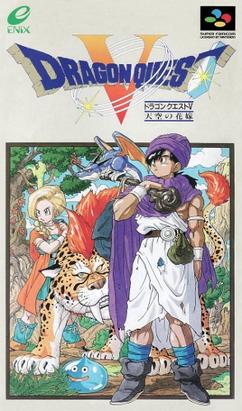
Dragon Quest V: Hand of the Heavenly Bride is a role-playing video game and the fifth installment in the Dragon Quest video game series, second of the Zenithian Trilogy. Originally developed by Chunsoft and published by Enix Corporation, Dragon Quest V was the first title in the series to be released for the Super Famicom video game console in Japan in September 1992. Dragon Quest V was the first game in the series to not be released in America due to programming issues at the time.

Dragon Quest Heroes: Rocket Slime is an action-adventure game developed by Tose and published by Square Enix for the Nintendo DS handheld video game console. It is the sequel to Slime Mori Mori Dragon Quest: Shōgeki no Shippo Dan for the Game Boy Advance. It was first released in Japan, and later in North America. It is a spin-off of the Dragon Quest series.
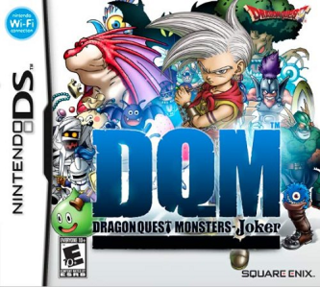
Dragon Quest Monsters: Joker is a 2006 role-playing video game developed by Tose and published by Square Enix for the Nintendo DS. It is the fourth installment of the Dragon Quest Monsters series. This was the first game in the series to have online play, done using Nintendo Wi-Fi. A sequel, Dragon Quest Monsters: Joker 2, was released in 2010.

Aggressors of Dark Kombat, known in Japan as Thrilling Intense March or GanGan, is a 1994 fighting arcade game developed by Alpha Denshi Corp. (ADK) and published by SNK. It was also released on SNK's Neo Geo AES and Neo Geo CD home consoles, and in later decades appeared on retro compilations and digital storefronts. The English game title uses the same initials as the developer and the title is parodying the name of Midway's Mortal Kombat series. The game's defining feature was that, while it uses a generally 2D format, characters can move towards or away from the screen. While some reviews praised this mechanic, critics generally remarked that it offers no meaningful innovation and that the game is generic and lacking in depth. Though a modest success, Aggressors of Dark Kombat failed to match the popularity of the leading SNK fighters.

Mega Man Star Force: Pegasus, Mega Man Star Force: Leo, and Mega Man Star Force: Dragon are 2006 action role-playing video games developed and published by Capcom for the Nintendo DS handheld video game console; combined, they are the first game in the Mega Man Star Force series, a sub series of the greater Mega Man franchise—and a follow-up to the Mega Man Battle Network series. It takes place in the years of 220X, in which technology has advanced to the point where the world is now connected through EM waves. The game follows Geo Stelar, a fifth-grader in Echo Ridge who merges with an FM-ian named Omega-Xis after mourning the supposed death of his father.
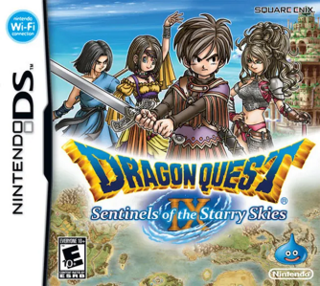
Dragon Quest IX: Sentinels of the Starry Skies is a role-playing video game co-developed by Level-5 and Square Enix for the Nintendo DS. Published by Square Enix in Japan in 2009, and by Nintendo overseas in 2010, it is the ninth mainline entry in the Dragon Quest series. The storyline follows the protagonist, a member of the angelic Celestrian race, after a disaster in their home scatters magical fruits across the mortal realm. While carrying over traditional gameplay from the rest of the series with turn-based battles, the game is the first Dragon Quest entry to feature a customizable player character, and the first to include a multiplayer mode, with the option of trading treasure maps and loaning player characters through Nintendo Wi-Fi. Online functions ended in 2014 when it ceased operations.

Digimon World Dawn and Digimon World Dusk, originally released as Digimon Story Sunburst & Moonlight in Japan, are two role-playing video games for the Nintendo DS handheld game console released in Japan on March 29, 2007 and North America on September 18, 2007. Together, they serve as the second instalment of the Digimon Story series, part of the larger Digimon franchise. Despite their western title, the games are not part of the Digimon World series.
Many significant Japanese historical people of the Sengoku period appear in works of popular culture such as anime, manga, and video games. This article presents information on references to several historical people in such works.

The Dragon Ball Z: Supersonic Warriors is a series of fighting games based on the Dragon Ball franchise. The first game was developed by Arc System Works and Cavia and was released for the Game Boy Advance on June 22, 2004. A sequel, Supersonic Warriors 2, was released in 2005 for the Nintendo DS.
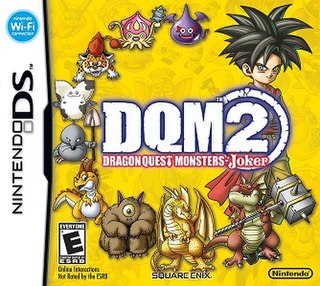
Dragon Quest Monsters: Joker 2 is a 2010 role-playing video game developed by Tose and published by Nintendo for the Nintendo DS. It is the sequel to Dragon Quest Monsters: Joker (2006) and is the fifth game in the Dragon Quest Monsters series. A sequel, Dragon Quest Monsters: Joker 3, was released in 2016.
Dragon Quest is a series of role-playing video games that originated in 1986 with the release of the first game in the series. Although the games are not related in terms of story, many aspects of the gameplay are consistent throughout the series. Each game in the series add new elements to the gameplay, such as longer quests, character classes, or different ways of story-telling.
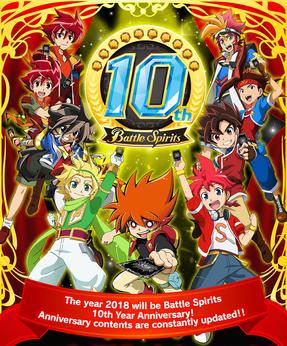
Battle Spirits is a two-player collectible card game (CCG) jointly developed by Bandai and Sunrise, Inc. and a franchise which also includes several anime series, manga serialisations, and other merchandise like toys and video games.
F-1 Spirit is a series of Formula One-based racing video games developed and published by Konami starting on the MSX in 1987.

Warriors Orochi 3, originally released as Musō Orochi 2 in Japan, is a 2011 hack and slash video game developed by Tecmo Koei and Omega Force for the PlayStation 3 and Xbox 360. This is the fourth installment of the crossover series Warriors Orochi, a combination of the Dynasty Warriors and Samurai Warriors series. This installment serves as a sequel to Warriors Orochi 2. The game was released in Japan in 2011, and in Europe and North America in 2012.

For Honor is an action game developed and published by Ubisoft. The game allows players to play the roles of historical forms of soldiers and warriors such as knights, samurai, and vikings, controlled using a third-person perspective. The game was developed primarily by Ubisoft Montreal and released worldwide for PlayStation 4, Windows, and Xbox One in 2017.

Fire Emblem: New Mystery of the Emblem is a tactical role-playing game developed by Intelligent Systems and published by Nintendo for the Nintendo DS handheld video game console in July 2010. It is the twelfth entry in the Fire Emblem series, and a remake of the Super Famicom title Fire Emblem: Mystery of the Emblem. The story is based on the original content from Mystery of the Emblem, while including a customizable Avatar as the main character alongside Marth, the protagonist of Shadow Dragon and the Blade of Light. New Mystery of the Emblem also adapts the story content from the Satellaview title BS Fire Emblem into four additional story episodes dubbed the "New Archanea Chronicles".
















